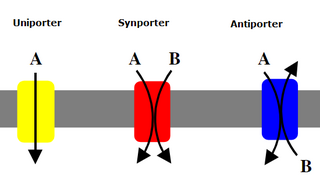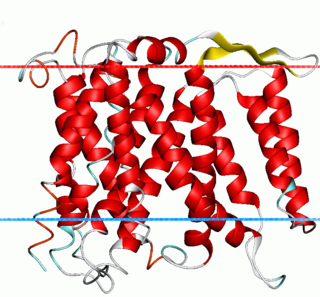Related Research Articles

An antiporter (also called exchanger or counter-transporter) is a cotransporter and integral membrane protein involved in secondary active transport of two or more different molecules or ions across a phospholipid membrane such as the plasma membrane in opposite directions, one into the cell and one out of the cell. Na+/H+ antiporters have been reviewed.

Members of the Solute:Sodium Symporter (SSS) Family (TC# 2.A.21) catalyze solute:Na+ symport. The SSS family is within the APC Superfamily. The solutes transported may be sugars, amino acids, organo cations such as choline, nucleosides, inositols, vitamins, urea or anions, depending on the system. Members of the SSS family have been identified in bacteria, archaea and eukaryotes. Almost all functionally well-characterized members normally catalyze solute uptake via Na+ symport.
The lysosomal cystine transporter (LCT) family is part of the TOG Superfamily and includes secondary transport proteins that are derived from animals, plants, fungi and other eukaryotes. They exhibit 7 putative transmembrane α-helical spanners (TMSs) and vary in size between about 200 and 500 amino acyl residues, although most have between 300 and 400 residues.
The Ca2+:cation antiporter (CaCA) family (TC# 2.A.19) is a member of the cation diffusion facilitator (CDF) superfamily. This family should not be confused with the Ca2+:H+ Antiporter-2 (CaCA2) Family (TC# 2.A.106) which belongs to the Lysine Exporter (LysE) Superfamily. Proteins of the CaCA family are found ubiquitously, having been identified in animals, plants, yeast, archaea and divergent bacteria. Members of this family facilitate the antiport of calcium ion with another cation.
Divalent anion:Na+ symporters were found in bacteria, archaea, plant chloroplasts and animals.
The Phage 21 S Family is a member of the Holin Superfamily II.
The HP1 Holin Family is a member of the Holin Superfamily II. Proteins in this family are typically found to contain two transmembrane segments (TMSs) and range between 70 and 80 amino acyl residues (aas) in length. A representative list of proteins belonging to the HP1 holin family can be found in the Transporter Classification Database.
The Holin Superfamily III is a superfamily of integral membrane transport proteins. It is one of the seven different holin superfamilies in total. In general, these proteins are thought to play a role in regulated cell death, although functionality varies between families and individual members.
The LydA Holin Family, named after the lydA gene which codes for its prototype member, belongs to the Holin Superfamily III. Members of this family have 3 transmembrane segments (TMSs) and appear to possess between 90 and 120 amino acyl residues (aas). A representative list of proteins belonging to this family can be found in the Transporter Classification Database.
The PRD1 Phage P35 Holin Family is a member of Holin Superfamily III. The prototype for this family is the lipid-containing PRD1 enterobacterial phage holin protein P35 encoded by gene XXXV (orfT). It is a component of a typical holin-endolysin system which functions to lyse the host bacterial cell.
The lactate permease (LctP) family is a family of transport proteins belonging to the ion transporter (IT) superfamily.
The arsenical resistance-3 (ACR3) family is a member of the BART superfamily. Based on operon analyses, ARC3 homologues may function either as secondary carriers or as primary active transporters, similarly to the ArsB and ArsAB families. In the latter case ATP hydrolysis again energizes transport. ARC3 homologues transport the same anions as ArsA/AB homologues, though ArsB homologues are members of the IT Superfamily and homologues of the ARC3 family are within the BART Superfamily suggesting they may not be evolutionarily related.
The Basic Amino Acid Antiporter (ArcD) family is a constituent of the IT superfamily. This family consists of proteins from Gram-negative and Gram-positive bacteria. The proteins are of about 480 amino acyl residues (aas) in length and have 10-12 putative transmembrane segments (TMSs). Functionally characterized homologues are in the DcuC and ArsB families. Some members of the family probably catalyze arginine/ornithine or citrulline/ornithine antiport.

Na+/H+ antiporter A (NhaA) family (TC# 2.A.33) contains a number of bacterial sodium-proton antiporter (SPAP) proteins. These are integral membrane proteins that catalyse the exchange of H+ for Na+ in a manner that is highly pH dependent. Homologues have been sequenced from a number of bacteria and archaea. Prokaryotes possess multiple paralogues. A representative list of the proteins that belong to the NhaA family can be found in the Transporter Classification Database.
The NhaC family belongs to the Ion Transporter (IT) Superfamily. A representative list of proteins belonging to the NhaC family can be found in the Transporter Classification Database.
The NhaD family belongs to the Ion Transporter (IT) Superfamily. A representative list of proteins belonging to the NhaD family can be found in the Transporter Classification Database.
The NhaE family belongs to the Ion Transporter (IT) Superfamily, which has an end. A representative list of proteins belonging to the NhaE family can be found in the Transporter Classification Database.

The Monovalent Cation:Proton Antiporter-1 (CPA1) Family (TC# 2.A.36) is a large family of proteins derived from Gram-positive and Gram-negative bacteria, blue-green bacteria, archaea, yeast, plants and animals. The CPA1 family belongs to the VIC superfamily. Transporters from eukaryotes have been functionally characterized to catalyze Na+:H+ exchange. Their primary physiological functions are thought to be in (1) cytoplasmic pH regulation, extruding the H+ generated during metabolism, and (2) salt tolerance (in plants), due to Na+ uptake into vacuoles. Bacterial homologues have also been found to facilitate Na+:H+ antiport, but some also catalyze Li+:H+ antiport or Ca2+:H+ antiport under certain conditions.
The Monovalent Cation (K+ or Na+):Proton Antiporter-3 (CPA3) Family (TC# 2.A.63) is a member of the Na+ transporting Mrp superfamily. The CPA3 family consists of bacterial multicomponent K+:H+ and Na+:H+ antiporters. The best characterized systems are the PhaABCDEFG system of Sinorhizobium meliloti (TC# 2.A.63.1.1) that functions in pH adaptation and as a K+ efflux system, and the MnhABCDEFG system of Staphylococcus aureus (TC# 2.A.63.1.3) that functions as a Na+ efflux Na+:H+ antiporter.
The inorganic phosphate transporter (PiT) family is a group of carrier proteins derived from Gram-negative and Gram-positive bacteria, archaea, and eukaryotes.
References
- ↑ Prakash, Shraddha; Cooper, Garret; Singhi, Soumya; Saier, Milton H. (2003-12-03). "The ion transporter superfamily". Biochimica et Biophysica Acta (BBA) - Biomembranes. 1618 (1): 79–92. doi: 10.1016/j.bbamem.2003.10.010 . ISSN 0006-3002. PMID 14643936.
- ↑ Pinner, E.; Padan, E.; Schuldiner, S. (1992-06-05). "Cloning, sequencing, and expression of the nhaB gene, encoding a Na+/H+ antiporter in Escherichia coli". The Journal of Biological Chemistry. 267 (16): 11064–11068. doi: 10.1016/S0021-9258(19)49875-X . ISSN 0021-9258. PMID 1317851.
- ↑ Enomoto, H.; Unemoto, T.; Nishibuchi, M.; Padan, E.; Nakamura, T. (1998-03-06). "Topological study of Vibrio alginolyticus NhaB Na+/H+ antiporter using gene fusions in Escherichia coli cells". Biochimica et Biophysica Acta (BBA) - Biomembranes. 1370 (1): 77–86. doi: 10.1016/s0005-2736(97)00245-9 . ISSN 0006-3002. PMID 9518558.
- ↑ Nakamura, T.; Fujisaki, Y.; Enomoto, H.; Nakayama, Y.; Takabe, T.; Yamaguchi, N.; Uozumi, N. (2001-10-01). "Residue aspartate-147 from the third transmembrane region of Na(+)/H(+) antiporter NhaB of Vibrio alginolyticus plays a role in its activity". Journal of Bacteriology. 183 (19): 5762–5767. doi:10.1128/JB.183.19.5762-5767.2001. ISSN 0021-9193. PMC 95471 . PMID 11544242.
As of this edit, this article uses content from "2.A.34 The NhaB Na+:H+ Antiporter (NhaB) Family" , which is licensed in a way that permits reuse under the Creative Commons Attribution-ShareAlike 3.0 Unported License, but not under the GFDL. All relevant terms must be followed.